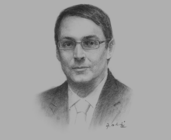OBG talks to Jim Stewart, CEO, Investment & Development Office, Government of Ras Al Khaimah

Interview: Jim Stewart
In terms of revenue, less than 20% of the government’s income is generated from other emirates. The majority of revenue is created in RAK itself and the proximity to other markets such as India and the wider GCC means that income sources are diverse. However, the emirate obviously benefits greatly from the infrastructure and services support which is provided by the federal government, and the proximity to our prosperous neighbours has a positive effect.
Overall, RAK enjoys an excellent platform for success due to being part of the UAE and having a favourable location. The extent to which that platform can be built upon, and the associated risks and rewards, are largely limited to the emirate’s own efforts.
Having reduced structural debt levels, how is policy forming to fund infrastructure development?
STEWART: RAK achieves a consistent annual government surplus, which is forecast to continue. Thus, most projects can be funded internally. For major developments, a combination of partnerships and diverse funding alternatives are available. The emirate holds an international “A” rating from both Fitch and Standard & Poors. This strong investment-grade rating means that there are numerous favourable options for RAK in terms of funding. Combined with low levels of debt and stringent debt management, the credit rating for the emirate is excellent and the long-term outlook is very positive. This means that, during this strong growth period, partners and funders are happy with the outlook and the strong fundamentals that make RAK an attractive selection for infrastructure funding.
How well has the public-private partnership (PPP) model performed and what opportunities exist?
STEWART: The government selects the best financing model for each project; there is no bias towards one model and the options are varied. The important factor is selecting the best partner for any major project – someone that can work with the government in achieving our goals. From there, we derive a business model that is structured to ensure that the project is going to be successful, viable and self-sustaining. The business model and the critical success factors generally drive the financing model, not the other way around. In addition to PPPs, we look at traditional project financing, equity partners and debt market participation. However, the emirate’s economic surplus and the size of projects in RAK means that the government can stand alone in many of its key developments.
Given the competition to attract foreign investors, what appeal does RAK have over its rivals?
STEWART: RAK has five ports, all in close proximity to the international airport, and the emirate is close to local and regional markets. The emirate charges no taxes and offers a quality labour force at competitive rates. These are the ingredients and the foundations for success for any business in RAK. In addition, the government is dynamic and transparent, and investors take comfort from the “A” rating. RAK firms have an enviable track record of growth and profitability, and this also adds to the confidence level of potential investors. The ease of business registrations and the various options are an added incentive, and the overall cost of doing business in the emirate is favourable.
In the post-crisis environment there were moves to divest a number of overseas assets. Has this now left the emirate unduly exposed to domestic risks?
STEWART: The emirate holds many overseas assets, but these are strategic in focus and restricted to those which add value and synergise with local activities. The emirate has a balanced portfolio of investments, but it is no coincidence that those which are based in RAK itself perform well. There are no tax issues, no foreign currency issues, and no management issues in RAK. In addition, internal investment stimulates the economy.
You have reached the limit of premium articles you can view for free.
Choose from the options below to purchase print or digital editions of our Reports. You can also purchase a website subscription giving you unlimited access to all of our Reports online for 12 months.
If you have already purchased this Report or have a website subscription, please login to continue.

